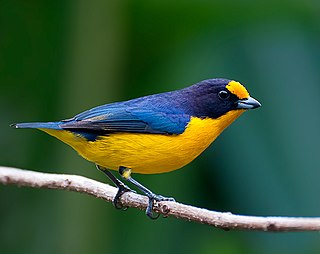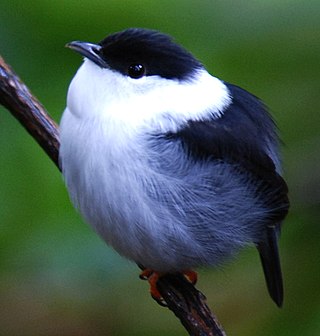
The spectacled thrush, bare-eyed thrush, or yellow-eyed thrush, is a resident breeding bird in the Lesser Antilles and in South America from Colombia and Venezuela south and east to northern Brazil. In Trinidad and Tobago, this thrush is also known as big-eye grieve.

The white-necked thrush is a songbird found in forest and woodland in South America. The taxonomy is potentially confusing, and it sometimes includes the members of the T. assimilis group as subspecies, in which case the "combined species" is referred to as the white-throated thrush. On the contrary, it may be split into two species, the rufous-flanked thrush and the grey-flanked thrush.

The violaceous euphonia is a small passerine bird in the true finch family. It is a resident breeder from Trinidad, Tobago and eastern Venezuela south to Paraguay and northeastern Argentina. The bird's range in northern Brazil is the lower portion of the Amazon Basin and the adjacent Tocantins River drainage, with its northwestern limits from Brazil and the Guyanas, the eastern banks of the Orinoco River drainage in central Venezuela.

The yellow-chinned spinetail is a passerine bird found in the tropical New World from Trinidad and Colombia south to Argentina and Uruguay. It is a member of the South American ovenbird family Furnariidae.

The white-bearded manakin is a small passerine bird which breeds in tropical South America. It can be found in Colombia, Venezuela and Trinidad south to Bolivia and northern Argentina. This manakin is found in forests, secondary growth and plantations. It is a small, plump bird about 10.7 centimetres (4.2 in) long. Males have a black crown, upper back, wings and tail and are otherwise white. Females are olive-green and resemble female golden-headed manakins. At breeding time, males are involved in lekking behaviour on the forest floor during which they puff out their neck feathers. This is a fairly common species with a wide range, and the International Union for Conservation of Nature has rated its conservation status as being of "least concern".

The wedge-billed woodcreeper is a sub-oscine passerine bird in subfamily Dendrocolaptinae of the ovenbird family Furnariidae. It is found in Mexico, Central America, Brazil, Bolivia, Ecuador, French Guiana, Guyana, Peru, Suriname, and Venezuela.

The ladder-tailed nightjar is a species of bird in the family Caprimulgidae, the nightjars. It is one of two species in the genus, Hydropsalis.

The dusky parrot or dusky pionus is a medium-sized mainly dark brownish-gray parrot of the genus Pionus in the true parrot family.

The cinnamon attila is a species of bird in the family Tyrannidae, the tyrant flycatchers. It is found in northern South America in the Amazon Basin of Brazil and the Guianas. It is found in Brazil, Colombia, Venezuela, Guyana, Suriname, and French Guiana; also Amazonian Ecuador, Peru, and regions of Bolivia. Its natural habitat is subtropical or tropical swamps.

The chestnut-belted gnateater is a species of bird in the family Conopophagidae, the gnateaters. It is found in the Amazon Basin of northern Brazil, southern Colombia and eastern Peru and Ecuador; also the Guianan countries of Guyana, Suriname and eastern French Guiana. Its natural habitat is tropical moist lowland forest.

The yellow-bellied dacnis is a species of bird in the family Thraupidae, the Tanagers. It is found in Amazonian regions of Colombia, Ecuador, Peru, Bolivia and Brazil; also the eastern Orinoco River region of Venezuela. Its natural habitat is the canopy of tropical humid lowland forest.

The yellow-crested manakin, also called the yellow-crowned manakin, is a species of bird in the family Pipridae, the manakins.

The fiery-capped manakin is a species of bird in the family Pipridae, the manakins. It is one of the five species in the genus Machaeropterus. It is named for its bright yellow head feathers.

The yellow-crowned elaenia is a species of bird in the family Tyrannidae, the tyrant flycatchers. It is found in eastern Orinoco Basin Venezuela, the Guianas, and along the Amazon River corridor; also Colombia, Brazil, Guyana, Suriname, French Guiana, Ecuador and Peru.

The chestnut-crowned becard is a species of bird in the family Tityridae. It has traditionally been placed in Cotingidae or Tyrannidae, but evidence strongly suggest it is better placed in Tityridae, where it is now placed by the South American Classification Committee.

The coraya wren is a species of bird in the family Troglodytidae, the wrens.

The spotted tody-flycatcher is a species of bird in the family Tyrannidae, the tyrant flycatchers. It is found in Bolivia, Brazil, Colombia, Ecuador, French Guiana, Guyana, Peru, Suriname, Trinidad and Tobago, and Venezuela, and is mostly a species of the Amazon Basin countries and Guianan countries.

The painted tody-flycatcher is a species of bird in the family Tyrannidae, the tyrant flycatchers. It is found in the Guianas of French Guiana, Guyana and Suriname; also eastern-southeastern Venezuela and the northeastern states of Brazil of the Amazon Basin.

The gilded barbet is a species of bird in the family Capitonidae, the New World barbets, and are close relatives of the toucans.





















